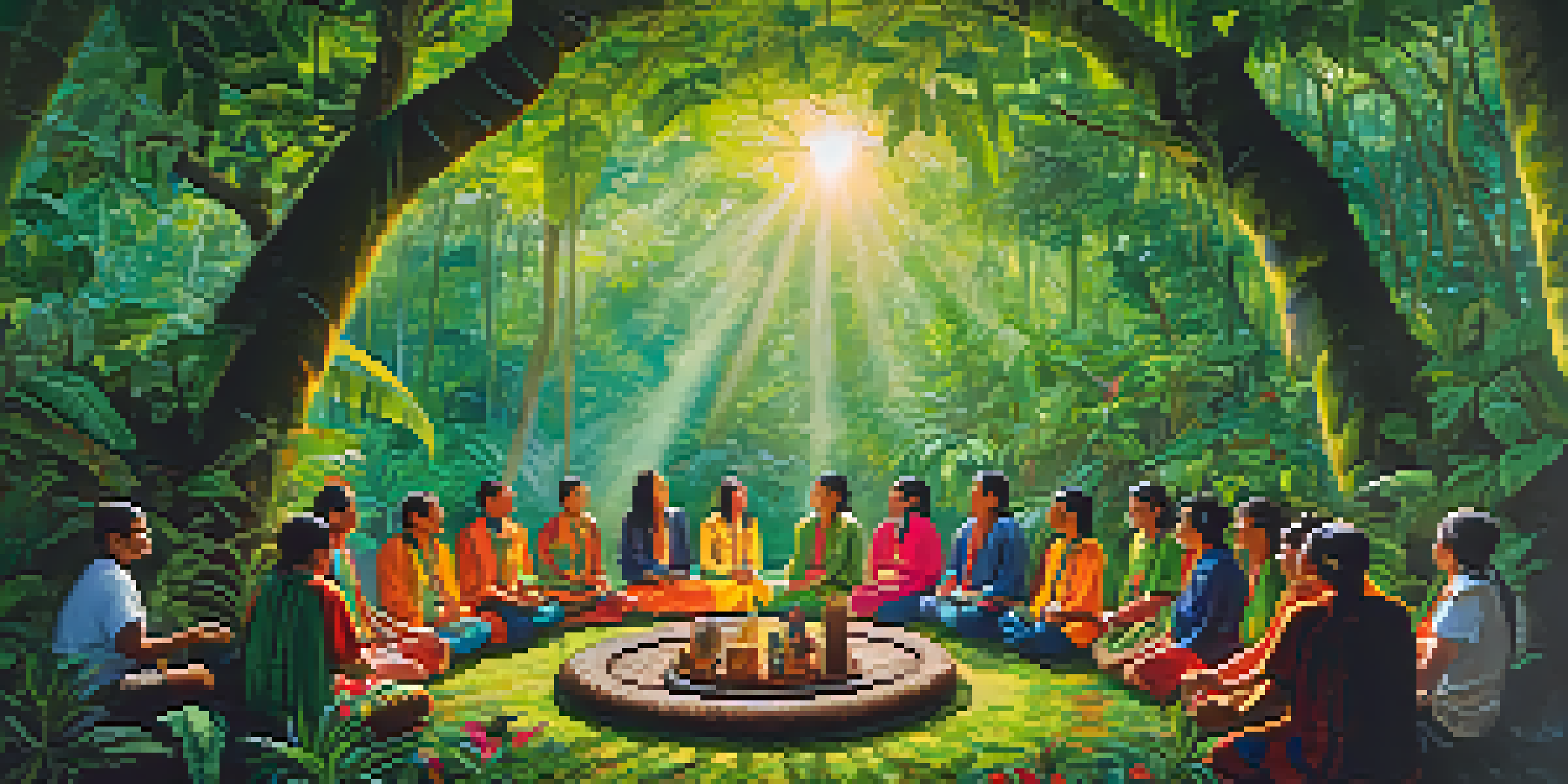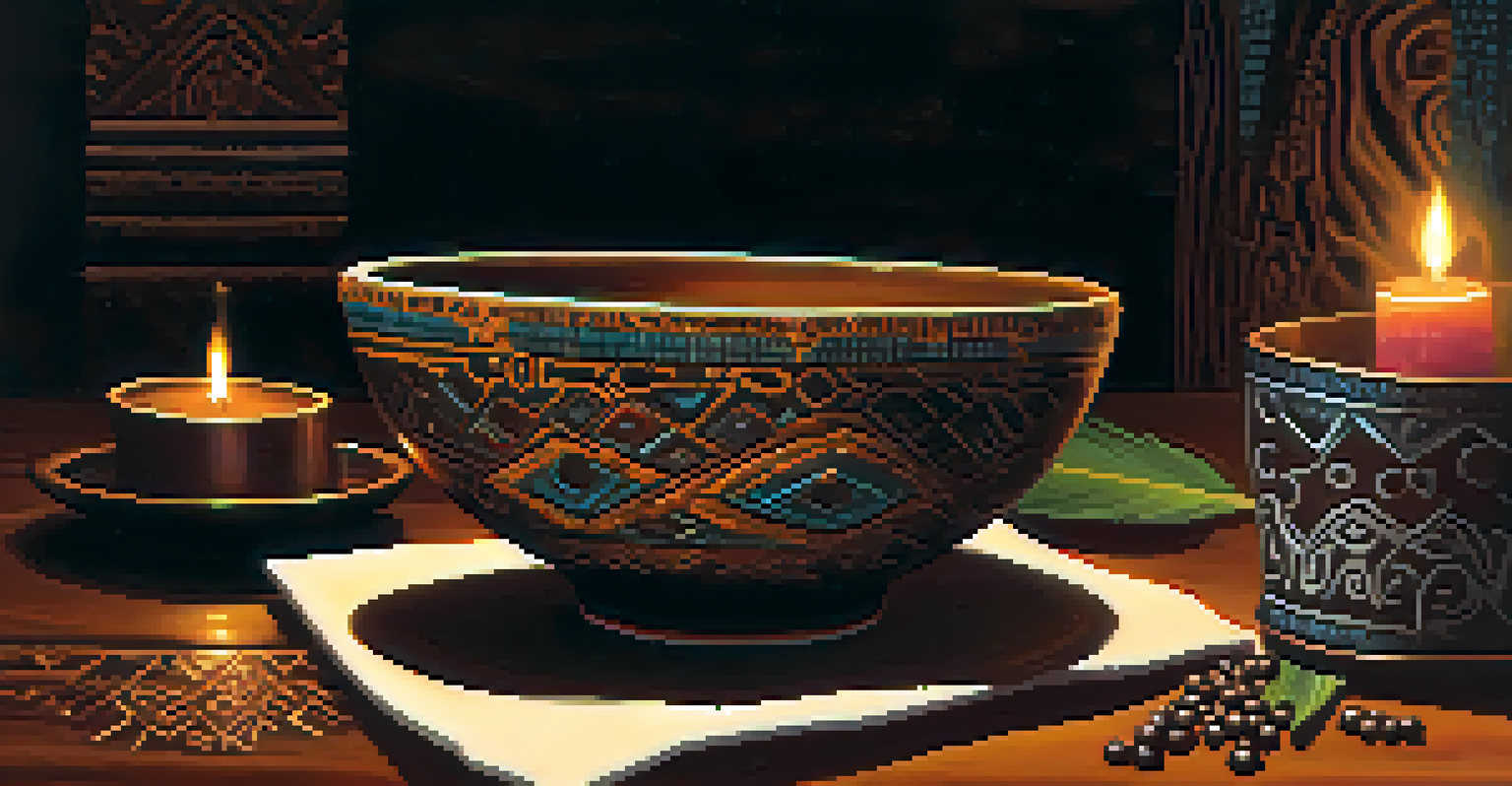Ayahuasca Ceremony: Navigating Emotional Landscapes

Understanding Ayahuasca: A Journey Begins
Ayahuasca is a powerful plant medicine, traditionally used by indigenous tribes in the Amazon for spiritual healing. It consists of two main ingredients: the Banisteriopsis caapi vine and the leaves of the Psychotria viridis plant. Together, they create a brew that many believe opens the door to profound insights and emotional healing.
The wound is the place where the Light enters you.
The ceremony usually takes place in a controlled environment, guided by a shaman who facilitates the experience. This guidance is crucial, as the journey can be intense and requires a stable atmosphere for participants to navigate their emotional landscapes. Understanding the roots of Ayahuasca can help participants approach their journey with respect and openness.
As the brew takes effect, participants often report experiencing a range of emotions, from joy to fear. This emotional rollercoaster is part of what makes Ayahuasca ceremonies so transformative. By being aware of what to expect, individuals can prepare themselves for an enlightening experience.
The Role of Intentions in the Ceremony
Setting intentions is a foundational aspect of participating in an Ayahuasca ceremony. Before the ceremony begins, participants are encouraged to reflect on what they hope to gain from the experience. These intentions act as a guiding light throughout the journey, helping individuals focus on their emotional and spiritual goals.

Intentions can range from seeking clarity on personal issues to healing past traumas. The clearer the intention, the more likely it is that the experience will resonate with that purpose. This personal focus can significantly enhance the depth of emotional exploration during the ceremony.
Understanding Ayahuasca's Purpose
Ayahuasca is a traditional plant medicine used for spiritual healing, often guided by a shaman to facilitate emotional exploration.
When participants are aligned with their intentions, they often find that the emotional landscapes they navigate become more manageable. This alignment fosters a sense of empowerment, allowing individuals to confront their fears and joys head-on, leading to potential breakthroughs.
Navigating Emotional Turbulence During the Ceremony
During an Ayahuasca ceremony, it's common for participants to encounter emotional turbulence. This can manifest as feelings of anxiety, sadness, or even anger. Understanding that these emotions are part of the healing process is essential for maintaining a sense of calm amidst the storm.
Healing is a matter of time, but it is sometimes also a matter of opportunity.
Many people find comfort in knowing that they're not alone in their emotional struggles. Sharing experiences with fellow participants can create a sense of community and support. This connection can be incredibly grounding, reminding individuals that they are part of a shared journey.
Having coping strategies in place can also help participants navigate these emotional waves. Techniques such as deep breathing, visualization, or simply surrendering to the process can aid in managing overwhelming feelings. The goal is to ride the emotional waves rather than resist them.
The Integration Process: Making Sense of the Experience
After the ceremony, participants often enter a phase known as integration. This is a crucial step where individuals reflect on their experiences and insights gained during the journey. Taking the time to process these emotions can enhance the long-term benefits of the ceremony.
Integration can take many forms, from journaling and meditation to discussing experiences with trusted friends or therapists. This reflective practice allows participants to connect the dots between their emotional landscapes and everyday life. It's about translating spiritual insights into actionable changes.
The Importance of Setting Intentions
Setting clear intentions before the ceremony helps participants focus on their emotional and spiritual goals, enhancing their experience.
Without integration, the powerful lessons from the ceremony may fade away. By actively engaging with the experience post-ceremony, individuals can create lasting changes in their emotional and spiritual lives, transforming fleeting insights into a new way of being.
Common Misconceptions About Ayahuasca Ceremonies
There are several misconceptions surrounding Ayahuasca ceremonies that can deter individuals from participating. One common belief is that these experiences are purely recreational or akin to drug use. In reality, Ayahuasca is a deeply spiritual and therapeutic practice, often requiring much preparation and respect.
Another misconception is that the experience is always positive or enlightening. While many participants do report transformative insights, the journey can also be challenging and emotionally taxing. This reality underscores the importance of having the right mindset and support system in place.
Lastly, some people view Ayahuasca as a 'quick fix' for emotional or psychological issues. However, true healing often requires ongoing work and integration long after the ceremony concludes. Understanding these misconceptions can help potential participants approach the ceremony with a more informed and realistic perspective.
The Role of the Shaman in Ayahuasca Ceremonies
The shaman plays a pivotal role in Ayahuasca ceremonies, serving as a guide and facilitator throughout the experience. Trained in traditional practices, shamans help create a safe and supportive environment for participants. Their knowledge of the brew and the healing process is invaluable.
During the ceremony, the shaman often uses songs, known as icaros, to navigate the energy of the group and enhance the participants' journeys. These songs, imbued with intention and healing vibrations, can help guide individuals through difficult emotional landscapes. They connect participants to the spiritual realm and foster a sense of community.
Navigating Emotional Challenges
Participants may experience emotional turbulence during the ceremony, but having coping strategies and support can aid in navigating these feelings.
Having a skilled shaman present can significantly impact the overall experience. Their ability to hold space and provide support can help participants feel more secure as they confront their emotions, ultimately leading to a more profound and meaningful journey.
Preparing for Your Ayahuasca Journey
Preparation is key to maximizing the benefits of an Ayahuasca ceremony. This involves not only setting intentions but also physical and mental preparation. Participants are typically advised to follow a specific diet and lifestyle changes leading up to the ceremony to ensure a more effective experience.
Mental preparation can include meditation, journaling, or discussing expectations with others who have participated in Ayahuasca ceremonies. Creating a supportive environment before the ceremony can help alleviate anxiety and promote a positive mindset. The more prepared you are, the more you can focus on the emotional landscapes that arise.

Lastly, it’s essential to approach the ceremony with an open heart and mind. Embracing uncertainty and being willing to face whatever emotions arise will enrich your experience. Preparing holistically—physically, mentally, and emotionally—sets the stage for a transformative journey.